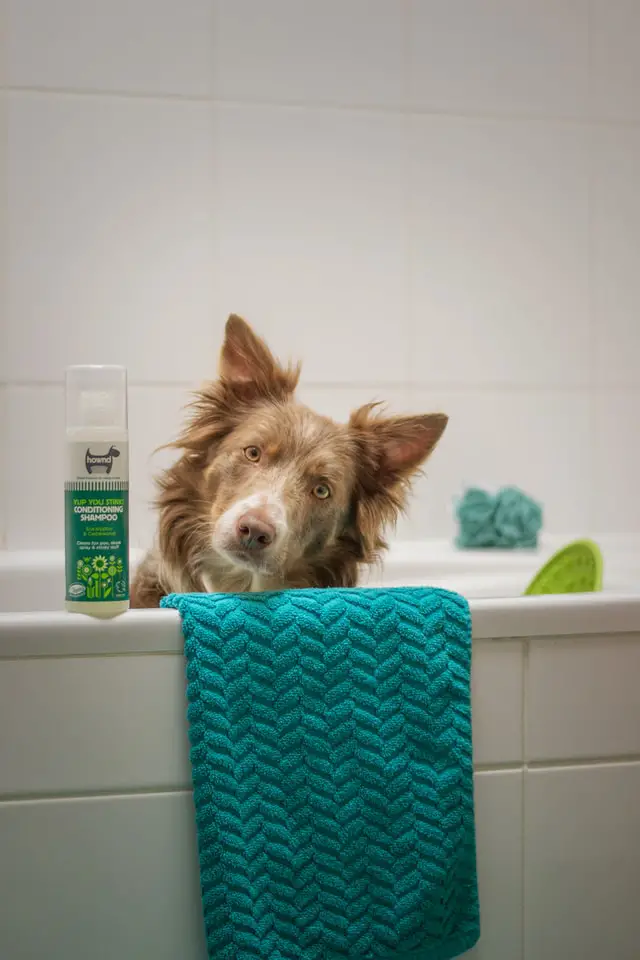It is not uncommon to see pink hair on dogs, including Border Collies, these days. But what if you find a dog with pink hair that you didn’t even dye? Developing pink, red, or rust-colored fur on canines is a sign of something wrong with their skin’s surface. Having that in mind, the problem must be checked, handled, and treated as earliest as possible.
Why Is My Dog Suddenly Pink or Red?

Same as their personality, the dog’s skin is one-of-a-kind. Relying on the pigments inherent to the breed or their specific genetic history, you can notice dogs with pink hair, or sometimes black — both are perfectly fine.
Yet, in the case of rust-colored or pink dog fur, the cause is usually nothing to be concerned about. Everything can be restored to normal following days of treatment.
What Are Possible Causes of Red/Pink Fur?
Dog coat staining is a common issue for Border collies or other fidos with white or light-colored fur. However, when your dog’s pristine white fur becomes pink or even brown, it might be disappointing. Perhaps, here are the possible causes why you usually see dogs with pink hair:
Yeast Infection
Yeast dermatitis or yeast infection is one of the most prevalent reasons for pink hair in white dogs. The overgrowth of fungus causes yeast infections in dogs. It will then lead to itching and may prompt a dog to lick or scratch the affected region. Because of the continual licking done to ease irritation, a dog’s hair might take on a reddish tint as a consequence of a yeast infection.
Porphyrins
Porphyrins, which are found in your dog’s body fluids, are most likely staining its fur pink. The concentration of this substance is generally high in your dog’s tears and saliva making these areas the most typical regions to turn reddish or pinkish.
Saliva and Tears

Both saliva and tears have porphyrins, which means discoloration all around the mouth and eyes is common. Dogs generate saliva and tears naturally, and some of them will inevitably end up on their fur.
Excessive Licking
Excessive licking will leave pink stains throughout the dog’s body area since your dog’s saliva includes porphyrins. This is the most common cause of stains on your dog’s body or paws.
Food Allergies
Food allergies might result in excessive licking, resulting in stains on your dog’s fur. Itching, poor coat condition, scratching, and ear infections are all symptoms of Border Collie food allergies.
Dogs, like people, can have sensitive reactions to almost anything. Some allergies, however, are more frequent than others. Corn, eggs, soy, dairy, and wheat are all common allergies of dogs to food. Beef, hog, lamb, and fish are all potential protein allergens.
Anxiety or OCD
Your dog’s pink fur could also be due to behavioral difficulties. There is a release of oxytocin when dogs lick, making them feel relaxed and happier. Licking is a calming method for Border Collies and other dogs. Your dog may lick itself to settle down once nervous or anxious. Licking their paws a lot is a marker of obsessive-compulsive disorder or OCD.
Parasites
Parasites are the guilty party behind the dog’s excessive licking, turning your dog’s fur pink. Fleas are the most typical prime suspect.
What is the Treatment for Pink or Red Dog Fur?

Initially, you’ll need to figure out what’s causing the problem, which you may do with the help of a veterinarian most likely if a yeast infection is a suspect for redness. Normally, this infection responds to antifungal dog shampoos or ointments primarily containing Chlorhexidine Gluconate and Ketoconazole as well as oral therapy because they are caused by fungi.
Home cures based on apple cider vinegar can sometimes help to eliminate an infection because of its natural antifungal effect. It also acts on the reddish stain on fur to fade with time. A dietary adjustment may be necessary for dogs with allergy-related infections, which may be done with the advice of a veterinarian.
How To Get The Pink Out of The Fur?
It’s critical to understand the underlying causes behind a dog with pink hair, yet several fur parents also want to discover the proper removal of the red stains. Fortunately, there are a few options to explore.
- The use of a whitening shampoo intends to brighten the dog’s coat while also removing stains.
- A tear stain remover is delicate enough to be used within the eye area. Using it can remove tear stains and stains all over the mouth area as well.
- Baking soda is a bleaching agent that comes from nature. This is also good for your dog’s skin, so it’s a great choice if your dog has a skin infection or allergies.
- Another helpful way to remove stains is through the application of corn starch and peroxide mixture.
- Between bathing, pet wipes are a terrific way of keeping your dog clean. They can assist in stain prevention by eliminating saliva and tears before they cause stains.
- Trimming your dog’s fur, especially all over the mouth and eyes, may aid in the removal or prevention of stains. But, if you want to shave a Border Collie having this kind of condition, it is important to ask a vet or a groomer first.
Any Prevention Options?

Saliva or tears usually enhance the pink dog fur. Keeping your furry buddy’s skin clean and dry is the best method to keep their white fur looking light. This is true when it comes to taking care of a Border Collie and other canines with tear staining disorders, as well as those with red or scarlet paws, ears, or genitals due to excessive licking.
If your dog’s paws or ears are prone to yeast infections, consider wiping his feet from wet hikes and patting his ears dry following a recent bath or swim. Reducing the hair surrounding the eyes and nose areas as short as possible will help to prevent discoloration in dogs with tear staining difficulties.
Conclusion
As you can see, there are many possible reasons behind your dog having pink hair. Some circumstances may not be worrisome and can be treated with home remedies right away. But still, the best way to figure out the prime suspect for it and discover the best way to treat it is to visit your veterinarian. Through that, you may properly address the issue of your dog with pink hair and that he may react well to the treatment plan that is right for him.


